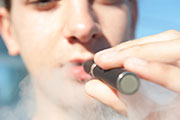
WEDNESDAY, May 7, 2014 (HealthDay News) — E-cigarettes may not be as harmless as they initially seemed. New research suggests that e-cigarette vapor produces tiny particles that users suck deep into their lungs, potentially causing or worsening respiratory diseases.
The particles are of comparable size to those contained in cigarette smoke, and as many as 40 percent of them reach the deepest part of the lungs when inhaled, said Jonathan Thornburg, lead investigator and a senior research engineer at RTI International, a North Carolina research institute.
That means if the particles turn out to be harmful, they’ll be causing damage throughout the lungs.
“These small particles have a high surface area-to-volume ratio,” Thornburg said. “When they deposit in your lungs, it makes it easy for whatever chemicals are in them to dissolve into your lung tissue.” Those chemicals potentially could cause or worsen respiratory problems such as asthma or bronchitis.
In its review of emissions from two types of e-cigarettes, Thornburg’s team did not find any toxic substances in the vapor produced by the devices.
“Everything we found was what the [U.S. Food and Drug Administration] and others generally regard as safe,” he said, noting that the cancer-causing agents produced by burning tobacco are not present in e-cigarettes.
But another new study raises the possibility that the liquids used to produce e-cigarette vapors could contain carcinogens or harmful ingredients, The New York Times reports.
The study found formaldehyde, a known carcinogen, in overheated vapor produced by high-power e-cigarette devices known as tank systems, the newspaper reported. These systems are larger devices than typical e-cigarettes, and are designed to vaporize liquid nicotine quickly to give users a bigger nicotine kick.
These studies provide even more impetus for the FDA’s recent proposal to begin regulating e-cigarettes as tobacco products, said Dr. Norman Edelman, senior medical advisor for the American Lung Association.
“We certainly don’t believe e-cigarettes are a safe alternative,” Edelman said. “The question is whether it’s a safer alternative, and we believe those results aren’t in yet. This is a tobacco product and should be regulated by the FDA as all tobacco products should.”
Thornburg and his colleagues tested the vapor from e-cigarettes using a new smoking machine built to replicate the physical experience of a 14-year-old boy using one of the devices.
They first tested an e-cigarette liquid designed to create a tobacco flavor. That liquid produced particles about 184 nanometers in size. A second liquid — this one with a fruit punch flavor — produced particles about 270 nanometers in size. Those are within the same range as the particles in cigarette smoke, according to Thornburg.
The researchers also found that 47 percent of the inhaled emissions deposited in the lungs, with nearly all of these particles reaching the deepest part of the lungs.
The remaining 53 percent of the emissions, when exhaled, create a potential source of secondhand exposure to people nearby, the study authors said.
The main ingredients found in the e-cigarette liquids are glycerin and glycol ethers, which are used as the liquid carrier into which all of the nicotine, flavorings and preservatives easily dissolve, Thornburg said. Those substances are not considered harmful.
Other ingredients included nicotine, the preservatives BHA and BHT, and chemicals that create the taste of caramelized sugar and the scent of citrus.
“It’s unknown whether these chemicals are harmful if you inhale them,” Thornburg said. “A lot of the chemicals are considered safe, but that’s from an ingestion perspective, not inhalation,” he noted.
According to Thomas Kiklas, CFO of the Tobacco Vapor Electronic Cigarette Association, “All constituents [of e-cigarettes] have been in the U.S. food supply for generations and all are approved by the EPA/FDA for human inhalation and use dermally.”
Kiklas contends, “The e-cig has and is being used by millions of Americans. There have been billions and billions of uses without a single incidence of harm.”
Thornburg said nicotine researchers need to come together and agree on a set of standards for researching e-cigarettes, given that there are so many different liquids and devices available.
“Each combination could create a unique exposure that could impact the user as well as bystanders,” he said. “With so many different potential combinations, we really need standardized methods for conducting the research with the devices we use and some liquids we use, so all of the research will be comparable.”
More information
For more information on e-cigarettes, visit the U.S. Food and Drug Administration.
Copyright © 2025 HealthDay. All rights reserved.

